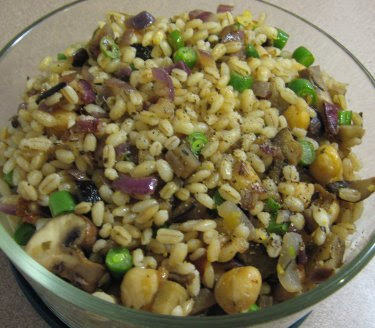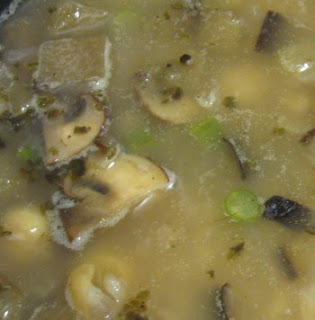 Three days' worth of barley salad:
Three days' worth of barley salad:barley
red onion
olive oil
eggplant
mushrooms
chickpeas
green beans
marjoram, sage, thyme, salt, pepper
dry vermouth for deglaze
Cook a cup or so of barley in a rice cooker or on the stovetop. Cook it exactly like rice. In fact, you could instead use rice, millet, quinoa, wheat berries, couscous, or bulgur wheat. Or I guess orzo. Barley is good, though.
While your grain cooks, make everything else. A hot grain salad of this type can take practically anything you throw at it, as long as those things go together. It can even take them if they don't quite go together, as in this case. I knew I wanted lots of chickpeas for protein, eggplant and mushroom for nice chewy business, and onion for onionitude. Then I needed to add something green. Normally I would want zucchini in something like this. Of course, we had no zucchini. We had the two pounds of frozen peas and a little bag of green beans. I dithered for a bit, then chose the green beans.
So. Warm olive oil in a sauté pan while you dice half a red onion. Throw the onion into the pan and let cook while you find the chickpeas in the refrigerator and chop up the eggplant and mushrooms. You can use as much of each of these as you prefer: add them to the pan, herbalize with some sage, marjoram, and thyme, and let cook on medium for about ten minutes, or until the eggplant and mushroom are both clearly becoming good and cooked.
While you're waiting, decide what green is most appropriate for your vegetables. Since I chose green beans, I cut them into tiny quarter-inch bits, then threw them into the pan for the last five minutes of cooking. Clearly something different would be required for, say, spinach (washing, destemming, chopping into bits small enough to melt appropriately), and you're certainly not going to chop up frozen peas. Do what makes sense.
When everything is about done, salt and pepper your vegetables. Pour a glug of vermouth into the pan and stir to deglaze any stuck bits. Then open the pan of grain, fluff it with a fork, and dump the whole thing into your pan of vegetables. Stir.
You have a delicious and happy salad. You can eat it right now.
You can also decide you don't want plain salad, but salad stuffed inside a pepper, or maybe a summer squash of some type, or a decent tomato if it happens to be summer. OK!
 Salad stuffed in a pepper
Salad stuffed in a pepperred pepper or other stuffing vegetable
cheese if you want it
the salad
Cut a pepper in half, cut the seeds out of the middle, and fill with salad. If you want cheese, you can either mix it into the salad or layer it inside the pepper. I used mozzarella, which necessitated cubing; other cheeses may want to be shredded or crumbled. Make sure to get some cheese on top for ultimate crispy brownness. If you don't want cheese, some bread crumbs or chopped nuts on top will get similarly crispy.
Put the peppers in a 375F oven and bake for maybe 15 minutes, or until the pepper is cooked through and the cheese has melted and browned appropriately. You may have to do some broiling to achieve this last bit, but I didn't, and everything worked out fine.
Put your leftover salad in the refrigerator and wait for tomorrow.
Tomorrow maybe you don't want salad at all. Maybe you want soup. Do you have some frozen broth, or can you make a quick vegetable stock? Ok then.
 Salad turned into soup
Salad turned into soupbroth
more of the salad
maybe some more pepper
toast
I used a big chunk of frozen chicken broth. Chuck your broth in a pan, melt if necessary, and bring up to a good boil. Add as much salad as you want. I would make sure there is a substantial broth to salad proportion going on, since barley likes to suck up as much liquid as possible. Cover the pan, turn down the heat, and simmer for maybe five minutes, or until all the salady bits are good and hot. In the meantime, make toast.
Now put soup in a bowl, dip bits of toast into it, and eat it all.
If you have any salad left over after this, I can't help you.